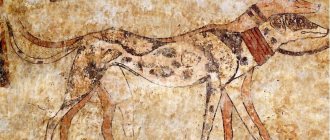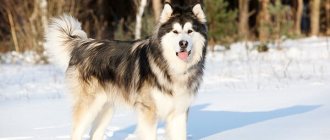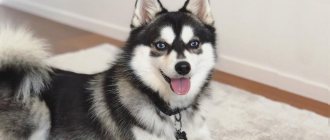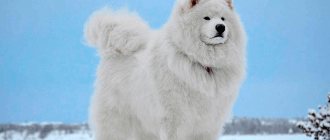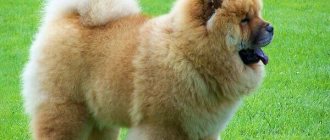The German Spitz is a breed whose history dates back about 2,500 years. Until now, in his homeland, he fulfills his main mission - guarding homes and participating in herding livestock. In our country, these dogs are better known as cute decorative pets, pleasing to the eye with fluffy fur and a fox-like muzzle. It is not surprising that small German Spitz dogs have taken over the whole world. But perhaps not everyone knows that there are several varieties of German Spitz - from fairly large ones to small, miniature ones.
Story
There is no exact version of the origin of the Spitz breed. What is known is that in Europe it is considered the oldest.
According to one assumption, the Spitz is a descendant of a peat dog, whose remains were discovered during archaeological excavations in 1860. The age of the found skeletons was assigned to the “Neolithic” period.
Dog breeding began already in the 15th century. But then these fluffy balls were different. Work on the species and natural evolution have made the breed what it looks like today.
The south of the Baltic is considered the homeland of dogs. Where they were brought in the 10th century. by the ancient Vikings, and for the next 3 centuries they carried out guard duty and also worked as shepherds in the fields. But later, aristocratic families began to have furry animals on their estates as companions.
Many great people preferred Spitz dogs. Their presence nearby helped create masterpieces of music, painting, and literature.
Brief history of origin and interesting facts
The breed has a rather interesting history - the Spitz descended from an ancient peaty dog that lived back in the Stone Age. According to the main version, the animals were bred in the Prussian province of Pomerania. The official history of the Spitz breed began in 1870. Then they adopted the first standard, and a year later they organized the Orange Club.
A few interesting facts will help you get to know this amazing breed better:
- A Pomeranian named Boo is the cutest dog in the world. He had a personal Facebook page that attracted millions of followers from all over the world. Unfortunately, Boo died in 2022 after living for 12 years.
- According to legend, the Pomeranian lived with Isaac Newton, who discovered the universal law of gravity. One day, a dog “stole” an entire year from the life of a scientist - he set fire to valuable manuscripts.
- Due to their decisive nature, representatives of the breed are often called little Napoleons.
- The breed became popular in 1888 after Queen Victoria fell in love with an Pomeranian while vacationing in Italy.
- Previously, only wealthy people could keep Pomeranians. Therefore, the breed has become a symbol of wealth and wealth.
Expert opinion
Leonid Rodin
Experienced dog breeder
Ask a Question
Riddle: “What unites Mozart, Chopin and Elvis Presley.” Answer: all of them at different times owned Pomeranian Spitz dogs and even dedicated musical works to them. In general, over the centuries of their life near people, Pomeranians have witnessed and participated in many interesting events. For example, the famous Michelangelo Buonarroti absolutely owned a small Spitz. Although now dog experts are arguing whether it was a Pomeranian dog or its Florentine counterpart. Of the 12 dogs on board the infamous Titanic, only three managed to survive - one Pekingese and two Pomeranians. The medieval theologian Martin Luther also had such a dog named Belferlane. The famous magician Harry Houdini also kept a Pomeranian. His dog's name was Charlie, and it was given to the American artist by someone from the Russian aristocracy during a tour in 1903.
Description of the breed
According to the description of the breed, a characteristic feature of the dog is its coat. The guard hair fits perfectly on top of the short down on the undercoat. Spitz dogs wear this “fur coat” only in cold weather; active molting begins in summer. The dog has the shape of a square.
The International Canine Association has determined the following Spitz breed standards:
- The dogs have the correct proportions.
- The back is short, wide and well muscled. The lumbar region is strong.
- The stomach is retracted.
- The chest is deep.
- Limbs – parallel, straight. The muscles are developed. There is fur on the back ones.
- The front legs are short. Brown in representatives of chocolate color, black in other dogs. The pads have dark, rough leather.
- The neck is located high relative to the body. Has a fluffy "mane".
- The head is elongated towards the center. The back of the head is much larger. The skull is oval.
- The muzzle resembles a “fox”. Proportional. The cheekbones are rounded.
- The nose is small, neat, and has a deep black nose.
- The lips are dry, tightly fitting, black (everyone except the Spitz is brown. His are black).
- The bite is regular, scissor-shaped. Complete dentition – 42 pcs.
- Ears are set high. They have the shape of a triangle.
- Eyes – oval, slanting, dark shades.
- The tail is medium-sized, arched over the lower back.
- The skin has no folds and fits tightly.
- Wool - double row. The outer part is long hair. The undercoat is short and resembles down.
- Height - Wolfspitz (another name is Keeshond) reaches 55 cm. Grossspitz - up to 50. The average Mittelspitz grows up to 38 cm. Small German Spitz (another name - Kleinspitz) - up to 29 cm. Miniature Spitz (another name - Pomeranian) only 18-22 cm at the withers.
- Weight corresponds to body parameters. Puppies do not gain 3 kg or more, mature ones - 30.
- The color of the Wolfspitz is silver/gray with black tips. Grossspitz – black, white, chocolate. Pomeranians come in black, white, red, chocolate, orange, and cream and tan.
Every country has its own opinion
Let us immediately note the fact that the German miniature and Pomeranian Spitz are classified as separate breeds in some countries. These include England, America and Canada. In Russia and Germany, the Pomeranian is considered a dwarf variety of the German Spitz.
The American Kennel Club standard can be found in the article “Pomeranian Spitz Breed Standard”. Next, we will describe the structure and characteristic features of the classic small (Kleinspitz), medium-sized (Mittelspitz) and miniature (Zwergspitz) German Spitz, officially accepted by the FCI and RKF.
The description of the standard features of the small group Spitz includes the structure:
- torso;
- heads;
- housings;
- limbs.
We will also talk about the coat, colors, sizes and temperament of these dogs.
Character and appearance
The dwarf Spitz is much larger in size than in reality. Therefore, these dogs have a cocky character and defiant behavior. Their loud, shrill bark can drive the most patient neighbors crazy.
Animals become strongly attached to their households. Spitz dogs experience separation from their owner very hard. German dogs always need the company of people. If the owner’s “ward” is in danger, the Spitz will immediately rush to defense, despite the size of its opponent.
Expert opinion
Anna Abramenko
An avid dog lover. Experience in veterinary medicine since 2009.
Ask a Question
The dog loves walks in the fresh air. This should be done at least 2 times a day. To avoid problems with an overweight dog, active games are recommended. But if the road to the walking area runs along the highway, the puppy should be kept on a leash. The Spitz is a very active dog and can run out onto the road.
The appearance of these dogs resembles a huge fur ball. Fluffy “clothing” prevents Spitz dogs from freezing during the cold season. The dog's muzzle resembles that of a fox.
There is always something to do with a Pomeranian. He is cheerful and energetic. For its loyal character and sociable disposition, this breed was preferred by many prominent people. An animal can even sincerely experience failures. The dog is not afraid of long journeys.
Differences between male and female
The gender of a Miniature German Spitz affects the dog's appearance and personality. For example, boys have the following:
- larger body;
- very fluffy and thick coat;
- Shedding is easier because less hair is lost;
- increased emotionality;
- They are almost incapable of cunning and manipulation.
But for a German Spitz Minik girl the following is characteristic:
- cleanliness;
- more balanced, calm character;
- the ability to manipulate and deceive;
- less expressed emotionality;
- frequent long-term shedding: before estrus, after childbirth.
But regardless of whether it is a girl or a boy, the pet will be devoted to its owner to the last, like a child.
Breeding
German Spitz dogs are bred in their historical homeland in Germany.
But Russia is not lagging behind Europe. Breeders are attracted to this breed because of its high profitability. For one puppy they give up to 70 thousand rubles.
But the presence of pitfalls in the process itself forces many to abandon this venture. Miniature Spitz puppies are very demanding and gentle to care for. In addition, small dogs are difficult to keep.
Below is the minimum cost item for high-quality Spitz breeding. (prices in the table are given in rubles):
| Advertising and promotion | 30 000 |
| Puppy cost | 60 000 |
| Feed | 15 000 |
| Medical service | 3 000 |
| Access to exhibitions | 15 000 |
| Appearance care | 10 000 |
| Keeping a dog | 5 000 |
| Dog handler services | 10 000 |
Multi-colored miracle of small stature
Spitz dogs of the small group differ from each other in height at the withers and weight. These parameters can be found in the table:
Deviations in height of no more than two centimeters in any direction are allowed, however, for a miniature Spitz, growth below 18 centimeters is undesirable. The dog's weight should be appropriate for its size.
Dogs of this breed have a rich palette of coat colors. They can be painted in one color: white, sable (blue), black, cream, brown and red of varying intensities. There is also a range of two or three colors - spots of the above shades are evenly distributed on the main white color.
The rarest and most expensive is the white Spitz. This is due to the fact that it is extremely difficult to breed a pure white color.
White dogs should not have a beige coating on their coat, especially around the ears. Brown or black Spitz dogs must not have a white spot on their chest. Zone grays should have “glasses” on their faces.
Education and training
Spitz dogs are known for their poise and obedience. Puppies are ready to learn new commands in any conditions. Dogs catch everything on the fly.
Despite an active desire to learn new things, they are characterized by fearfulness and increased nervousness. This is the main factor that prevents dog handlers from training Spitz dogs. But a short amount of work on adjusting the puppy’s character helps to quickly get rid of this.
In order to raise a dog correctly, you need to decide on the purpose of purchasing a puppy as early as possible. There are different types of Spitz training. Some are aimed at preparing companions and faithful comrades for the owner. Others are able to make them brave hunters and home guards.
Helpful Tips:
- Don't raise your voice. Spitz dogs are shy. Especially at the stage of meeting a new person. Screaming can disturb their psyche and create a barrier to learning. The right thing to do is reward your puppy with dog treats.
- Subsequence. Avoid overloading. You need to do no more than 5 minutes, but several times a day. It is also worth monitoring the execution of the command not only during the lesson, but also in the future.
- Using your favorite toys.
- It is better to contact a professional who has experience in training four-legged animals.
How to raise a friend?
Training a small Spitz is a pleasure. Mini dogs have a sharp mind and passion when following commands. Difficulties may arise with encouragement. The small size of the dog does not allow it to eat a lot of treats. The dog becomes full and refuses to follow commands. It is important to learn how to play and reward your pet with fun games. With motivational training, seven repetitions are enough for a dog to learn one command. 15-minute lessons a day will be enough to learn the basics of obedience.
Consistency and complexity of actions, as well as the dog’s high interest in the game will also help with training. In case of negative reactions, for example, loud barking, it is enough to show the toy to distract the pet from the desire to bark.
Review from the owner of a dwarf Spitz:
How a shepherd protects me and the apartment from passers-by or other family members. Even if she is sleeping or engrossed in a game, she will always accompany her mistress where she is going and will definitely wait. Now he is slowly getting used to the sweater. He constantly hides food throughout the apartment, otherwise they won’t give it anymore). In general, I have never seen such a lively, sweet, smiling and intelligent dog, and I definitely recommend it to everyone.
Oksana
Photo of a spitz with a leaf-shaped toy
Care and maintenance
Particular attention is paid to the pet's fur. It is thick and long. In summer, dogs shed heavily, a process that helps them maintain normal body temperature in the heat and prepare for the new cold season.
Expert opinion
Anna Abramenko
An avid dog lover. Experience in veterinary medicine since 2009.
Ask a Question
Short haircuts for Spitz dogs are strictly prohibited. The dog may have a cold.
The main thing is to brush the dog regularly until the “coat” is completely renewed. Otherwise, the Spitz's hair will begin to gather in lumps that will have to be cut off.
This is interesting: How to distinguish normal Spitz shedding from pathological
Many pet beauty salons provide grooming services. This is an expensive undertaking and is only used before an important exhibition.
What is the difference between a German Spitz and a Pomeranian?
The first difference is height. Some reach 50 cm, others 22 cm. But this is hard to see in the photo.
There are some nuances in appearance:
- Head. In a German, it is round, without pronounced cheekbones and cheeks. The ears are pointed and set high. The Pomeranian has a cylinder-shaped head. The ears are small, invisible behind the long hair.
- Teeth. A classic Spitz always has 42 of them. A species individual may lack several of them.
- Paws. The German's forelimbs are thin and underdeveloped. In the Pomeranian they are thick, stocky, and located perpendicularly.
- Tail. The German has it twisted (1-2 rings). The Pomeranian is straight.
You can read more about the differences in this article.
Free and easy gait
Widely spaced, straight forelimbs are clearly placed under the body of the Spitz. The shoulders extend 90 degrees from the shoulder blades, and the metacarpus extend 20 degrees from the vertical. Both the shoulders and pasterns should not have any curvature. The hind legs are parallel to each other and covered with fluffy “pants.” They protrude slightly beyond the seat line. The knees should not be turned in or out and the hocks should not be close.
The dog's rounded paws are reminiscent of a cat's in their neatness, closely spaced toes, rough pads and black strong claws. Sometimes Spitz puppies are born with dewclaws. In this case, they need to be removed in the first three to six days after the baby is born.
Thanks to its well-developed muscles, the animal can move freely and easily, springing off the ground. The dog should not mince or wag.
Health and illness
German Spitz dogs have good immunity. Only genetic predisposition has a strong influence. It is important to see the puppy's parents in person before making a purchase. In this way, you can protect yourself from many dog health problems.
The most common Spitz diseases are:
- cryptorchidism;
- weak digestive tract (in puppyhood);
- tracheal collapse;
- dislocation of the kneecap;
- portosystem shunts;
- problems with baby teeth.
This is interesting: At what age do dogs change their baby teeth?
There are no dogs that are not bothered by anything. In order to reduce the risk of the disease, it is worth contacting your veterinarian twice a year for a comprehensive general examination. And also monitor the dog’s condition at home.
Expert opinion
Anna Abramenko
An avid dog lover. Experience in veterinary medicine since 2009.
Ask a Question
If the dog is lethargic and behaves unnaturally, this is a reason to consult a doctor. Lack of appetite is the main signal of illness.
Proper care and a balanced diet will keep your beloved pet healthy for many years.
Character of Pomeranian Spitz
The Pomeranian is a devoted friend and brave protector. From his ancestors - German Spitz - he inherited courage, endurance, and energy. These dogs are curious, always on the move and exploring the world around them. They need the opportunity to run around and burn off energy, so walks should be active, with active games.
The Pomeranian becomes very attached to its owner and senses his mood. If they don't pay attention to him, he will be sad. The dog is ready to accompany the owner everywhere, support him in any games, amuse him and express his joy with a ringing bark. She can attract the owner's attention in different ways. This pet loves all family members, but becomes attached to only one, and is very sad in his absence.
Pomeranians are characterized by the following qualities:
- activity;
- good nature;
- devotion;
- curiosity;
- sociability;
- agreeableness;
- cleanliness;
- intelligence;
- cockiness;
- restlessness.
The Pomeranian Spitz is wary of strangers. Although he does not show aggression, he does not allow himself to be touched. And if threatened, it can attack and bite. Gets along well with children and pets if he grew up with them. Due to the hunting instinct, it is undesirable to keep Pomeranians in the same house with birds and rodents
Education and training
Pomeranians are very intelligent for a toy breed. Their intelligence and intelligence were inherited from their ancestors who served man. And now these little dogs can work in the police or rescue service, guard the house or clear the area of rats.
They are able to learn any commands and skills. But they are best at those that require a lot of movement. The commands “fetch” and “fetch” are especially easy to learn; they can learn agility, freestyle, and frisbee.
You need to start training your pet as early as possible. Spitz dogs strive for dominance and can be stubborn, so you need to immediately show your pet who’s boss. In the first six months of life, the dog must learn the rules of behavior in the house and on the street, understand the commands “no”, “come to me”, “place”, “sit”, “stand”, “near”, “fu”. It is important to teach your Pomeranian not to bark constantly, especially if he lives in an apartment building.
Education should be consistent, persistent, but gentle. Physical punishment should not be used; in response to such an attitude, he may become capricious and aggressive. It is better to interest the Pomeranian and reward him for correct behavior with affection or a treat.
Lifespan
The maximum age of a Spitz directly depends on its size. The larger the individual, and the greater the weight of the adult dog, the longer it will please the owner. There are many factors that influence longevity.
The average life expectancy of German Spitz is 6-15 years. In some cases - up to 20.
What can shorten a dog's years:
- Urban environment. A Spitz, like any animal, will live longer away from noisy highways and city bustle.
- Genetic diseases. What was passed on to the puppy from the parents. The health factor is important.
- Fractures, dislocations. You should be careful about the condition of your pet's bones. The Spitz skeleton is very fragile and a limb can easily be damaged.
- Fractures, dislocations. Lack of vitamins and minerals. An unbalanced diet will lead to a general weakening of the immune system.
- Stress. Spitz dogs have a weak nervous system. They are subject to overload and are acutely sensitive to separation from their owner.
- Lack of medical care. If a dog is not vaccinated and its health is not monitored, this can affect its quality of life.
- Overheat. A very dangerous and harmful factor. The dog should not be allowed to remain in the heat for a long time. Due to the length of their coat, Pomeranians are susceptible to heat stroke.
Loyal guard and excellent companion
Spitz are energetic, moderately excitable dogs. Like all guards, they have courage and vigilance, signaling the approach of a stranger with a loud bark. Animals are infinitely devoted to their owner, catch every word, love to please and can adapt to the rhythm of his life.
They treat strangers with suspicion and sometimes attack large dogs. You can find out more about the habits and character of representatives of this breed in the article “Description of small German Spitz”.
Deviations from the standard are considered to be such manifestations of temperament and behavior as cowardice, aggressiveness, timidity, excessive excitability, loss of coordination of movements, and lethargy.
List of best nicknames
When you decide to buy a pet, you should not hesitate to choose a name for it. The sooner the owner of the dog decides, the sooner it will understand and get used to the commands.
Sometimes the family does not know exactly what to name the puppy until the last moment. Many people want to understand this the first time they see it. In such a case, it is recommended to go after the dog already knowing several nicknames.
Top 10 popular nicknames for girls:
- Gloria,
- Lyme,
- Linda;
- Silvia;
- Desi;
- Tina;
- Squirrel;
- Betta;
- Lada;
- Rita.
For boys:
- Alex;
- Barley;
- Mauro;
- Cross;
- Leo;
- Oscor;
- Punch;
- Tyler;
- Tony;
- Yashka.
Rules for choosing puppies
Buying a dog should be taken seriously. After all, how long she will live depends on it. It is recommended that the decision be made thoughtfully and within the family circle.
What to pay attention to before purchasing:
- Reviews about the breeder. Having chosen a breed, it is better to find out as much information as possible about the nursery. Search the Internet or interview those who have already purchased puppies there.
- Animal genetics. If the owner of the litter does not show the dogs' parents, this indicates the presence of problems with their health.
- Help from a professional. If among your circle of acquaintances there are dog handlers or those who understand this, you should invite him with you.
- Documentation. The seller is obliged to provide information about the nursery, the official business of the breeder, and vaccination of animals.
Bright sexual coloration
Looking at a Spitz, you can immediately understand whether he is a male or a female, because this breed has a clearly defined sexual type. Impressive boys look courageous, their fur is longer and thicker than that of girls. Also, females are slightly smaller than males.
Males must have two developed testicles, fully descended into the scrotum.
If your dog has any deviations from the norm, this does not mean that he cannot become your good friend and faithful travel companion. Of course, the dog may not get to the show, but because of this it will not stop loving and respecting you.
You can tell us about the characteristics of your pet in the comments.
If you liked the article, please like it and share it with your friends.
German Spitz cost
The price for one puppy varies from 10 to 150 thousand rubles. A dog of rare colors will cost several times more. The seller will also ask “from above” for the titles of the Spitz’s parents and their participation in exhibitions.
It matters where the dog was bred. In large cities prices tend to be higher.
Expert opinion
Anna Abramenko
An avid dog lover. Experience in veterinary medicine since 2009.
Ask a Question
You need to understand that a reliable breeder will not be able to set a low price for their puppies, because the cost of high-quality care for a Spitz will cost several zeros.
Reviews
“A miniature Spitz is a friendly, cheerful, cute dog that attracts attention. They are hardy and very playful and affectionate. By nature, Nesuna dogs will actually endlessly and tirelessly fetch the ball that you toss to them. You'll get tired faster."
“Spitz are like teddy bears, they run and roll like little buns. And how smart they are. When we walk with them, they do not leave each other. So wonderful. I want to constantly squeeze and caress them. And you can’t tell that these are dogs. Like toys."
“Fluffy little ball. The dog is easy to train. Gets along with children. Easy to care for. But your Spitz should be fed with high-quality food to avoid health problems. This is a very active, mischievous dog, suitable for a family with children.”
With a flat back and a round tail
Along the wide and short back there is a straight line of the spine. A sagging back or convex spine is not allowed. The dog's croup should be slightly sloping, but not straight or low.
An integral part of the Spitz silhouette is a well-furred tail, curled into a ring and lying tightly to the back. The tail rises immediately where the line of the back ends, neither higher nor lower. A straight, hairless tail that hangs to one side or down is a serious fault.
The rounded ribs give the dog's chest a wide and relatively spacious appearance. However, they should not make the chest into a barrel shape. The Spitz's abdomen is taut, straight, without excess subcutaneous fat. A saggy belly indicates obesity. You should not allow your abdomen to become too retracted.
Photo and video review
Seeing these dogs in the photo, you get the impression that a small, fluffy ball of fur is depicted. Only a prominent black nose and short pointed ears will remind you of who he really is.
Dozens of Spitz colors have been bred. Below is a photo and video gallery that contains all the varieties of the dwarf German breed.
If you want to acquire a reliable companion, a faithful comrade or a source of inspiration for the next 12 years, then this breed is an ideal option. Despite the length of the coat, the dog does not require serious care. But the Spitz will bring joy to children and fill the house with cheerful, ringing barks.
Square – correct, rectangle – deviation
Spitz dogs have dry and strong bones without a rough feel, which adds harmony to their physique. The dog's muscles must be well trained. Excessive lightness or coarseness of the skeleton, weak muscles or massive body structure are considered deviations from the norm.
Small representatives of the German Spitz breed have a square body format with an index of 100 by 103, that is, the body length is almost equal to the height at the withers. Short or very elongated formats are considered defects.


